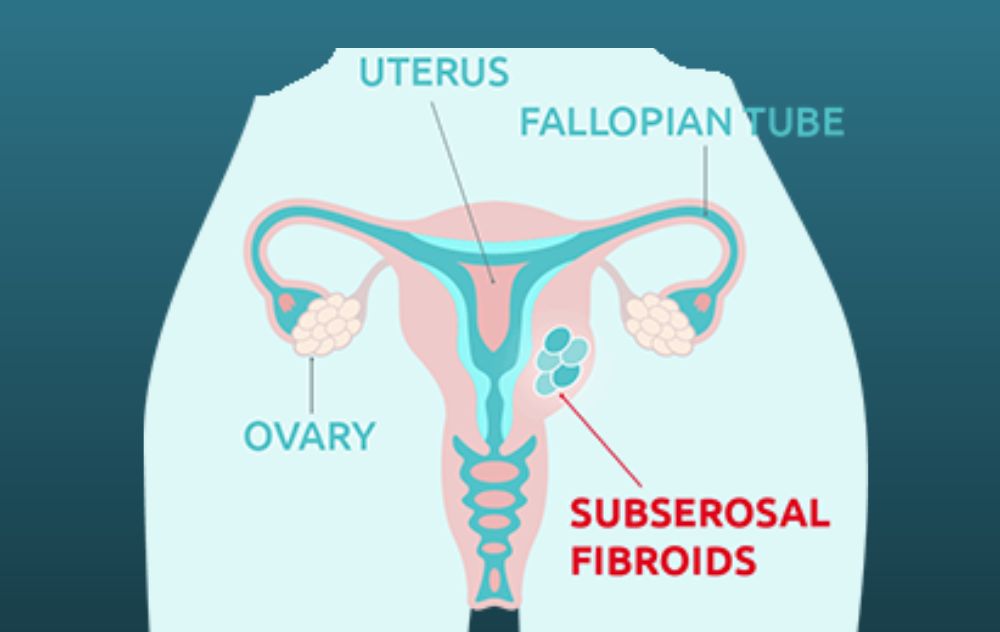
Fibroids, or noncancerous growths in the uterus, can appear in different locations. These locations determine the type of fibroid and the symptoms it can cause. By understanding the different types of fibroids and their effects, you can learn more about symptoms and treatment. In this guide, we’ll explain subserosal fibroids or fibroids that grow outside the uterus.
Where are Subserosal Fibroids Located?
Medical professionals classify fibroids by location because their place in or on the uterus influences the symptoms they cause. Intramural, submucosal and cervical fibroids all appear inside the uterus. As a result, they can cause issues with uterine function. Meanwhile, subserosal fibroids grow on the outside of the uterus and have an impact on the surrounding organs. They put pressure on the bladder, bowels, and abdomen.
Subserosal Fibroids Symptoms
A subserosal fibroid’s size and location change the issues it causes. Small fibroids don’t always cause symptoms because they put little to no pressure on your organs. Meanwhile, larger fibroids that grow on certain parts of the uterus can result in issues such as:
- Frequent urination
- Difficulty emptying the bladder
- Bloating
- Constipation
- Abdominal cramping or pain
- A heavy or full feeling in the abdomen
- A protruding abdomen or belly
Since everyone has a different experience with fibroids, you could have some, all, or none of these symptoms. Many women with uterine fibroids have them in multiple locations. When you have more than one type of fibroid in your uterus, you could experience symptoms associated with each class of fibroid.
Do I Have Subserosal Fibroids?
Only a trained medical professional can tell if you have subserosal fibroids. Diagnosing fibroids involves specialized equipment and advanced medical knowledge. The radiologists at USA Fibroid Centers may use one of the following diagnostic methods:
- Ultrasound: When your radiologist uses ultrasound to examine your uterus, a machine creates an image using sound waves. They might pass the device over your abdomen or insert it into your vagina.
- Magnetic resonance imaging (MRI): An MRI involves the use of magnets and radio waves to create an image of your uterus. You may need an MRI if an ultrasound doesn’t provide a sufficient picture.
If you receive a positive diagnosis, we can help you relieve your symptoms through minimally invasive treatment. You can take our fibroid symptom checker quiz to determine your risk of having fibroids.
How Serious is a Subserosal Fibroid?
Subserosal fibroids, which grow outside the uterus and protrude into the pelvic cavity, are generally considered less serious than other types of fibroids such as submucosal fibroids, which grow inside the uterine cavity and can cause significant symptoms. While subserosal fibroids may not directly affect menstrual bleeding or fertility, they can lead to discomfort or pain, especially if they grow large or press on surrounding organs. In some cases, subserosal fibroids may cause symptoms such as pelvic pressure, back pain, or frequent urination. Additionally, large subserosal fibroids may increase the risk of complications during pregnancy or childbirth, such as placental abruption or fetal malpresentation. While subserosal fibroids are usually benign and rarely develop into cancer, their impact on a woman’s quality of life and reproductive health should not be underestimated, and treatment options should be explored based on individual circumstances and symptoms. Regular monitoring by a healthcare provider is essential to assess the growth and impact of subserosal fibroids and to determine the most appropriate course of action.
Connect with USA Fibroid Centers
At our centers, we provide a minimally invasive alternative that preserves the uterus and offers a shorter recovery. Our fibroid specialists specialize in Uterine Fibroid Embolization (UFE). UFE works best at treating both Intramural and Subserosal fibroids. During UFE, your doctor uses ultrasound to locate your fibroids and the arteries that lead to them. Once they locate your fibroids, they insert a small catheter through a tiny incision in your groin or wrist. The doctor then injects an embolic agent (like small beads) that blocks the arteries that supply blood to the fibroids. This procedure is outpatient, so you are able to return home following your procedure.
Let our experts help you get relief from subserosal fibroids. We welcome you to schedule an appointment online at one of our USA Fibroid Centers clinics across the United States.



